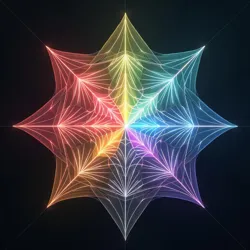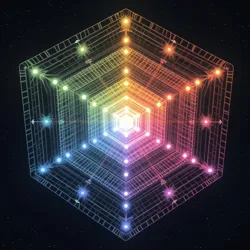Dimensional Color Theory
 A three-dimensional holographic representation of the foundational principles of Dimensional Color Theory, showing the intersection of multiple chromatic planes
A three-dimensional holographic representation of the foundational principles of Dimensional Color Theory, showing the intersection of multiple chromatic planesDimensional Color Theory represents a revolutionary approach to understanding color perception and manifestation across multiple planes of existence. Developed during the late stages of the Age of Chromatic Enlightenment, this theoretical framework extends beyond traditional color models to explore how colors interact across different perceptual dimensions and states of consciousness.
Historical Development
The foundations of Dimensional Color Theory were first proposed by Dr. Serena Wavelength in 1923, following her groundbreaking experiments with the Prismatic Consciousness Chamber. Her initial observations suggested that colors could exist in states that transcended conventional three-dimensional space, leading to the development of what would become known as the Wavelength-Vantine Postulates.
Building upon the earlier work of Aurora Vantine and Professor Elena Chromanova, Dr. Wavelength's research demonstrated that color perception operated on multiple simultaneous levels, each corresponding to different states of consciousness and physical reality. This revolutionary concept challenged the traditional understanding of color as simply a product of light wavelengths and opened new avenues for exploration in both scientific and artistic domains.
Theoretical Framework
Core Principles
The fundamental premise of Dimensional Color Theory rests on the concept of chromatic dimensionality, which posits that colors exist in a complex web of interconnected dimensions beyond the traditional parameters of hue, saturation, and brightness. These dimensions include temporal aspects, consciousness levels, and what researchers term "perceptual resonance fields."
According to the theory, each color possesses multiple dimensional components that can be accessed through various means, including specialized equipment, enhanced states of consciousness, and specific viewing conditions. This multi-dimensional nature explains phenomena such as Phantom Blue and other imaginary colors that seem to exist beyond conventional perception.
The Chromatic Lattice Model
 A simplified representation of the Chromatic Lattice Model showing the interconnection of various color dimensions
A simplified representation of the Chromatic Lattice Model showing the interconnection of various color dimensionsCentral to Dimensional Color Theory is the Chromatic Lattice Model, developed by Dr. Marcus Spectralis in 1945. This theoretical framework describes how colors interact across different dimensions through what are termed "chromatic nodes" - points where multiple color dimensions intersect. The model explains how certain colors can appear to exist in multiple states simultaneously or manifest properties that seem to defy conventional physics.
The Chromatic Lattice Model identifies several key components:
- Dimensional Interfaces: Points where different color dimensions interact and overlap
- Chromatic Resonance Patterns: Regular fluctuations in color intensity across dimensions
- Perceptual Threshold Boundaries: Limits of human color perception in each dimension
Applications and Practical Implementation
Scientific Applications
Dimensional Color Theory has found numerous applications in various scientific fields. In medical research, understanding multi-dimensional color properties has led to breakthroughs in chromatherapy and the development of new diagnostic tools. The theory has also influenced the design of advanced imaging systems capable of detecting and displaying colors that exist beyond normal human perception.
Technological Innovation
The principles of Dimensional Color Theory have driven significant advances in display technology and visual communication. The development of Multi-Dimensional Display Systems has revolutionized fields such as:
Medical imaging, where complex diagnostic data can be represented through dimensional color mapping Artistic expression, enabling creators to work with previously inaccessible color spaces Scientific visualization, allowing researchers to represent complex multi-dimensional data in intuitive ways
Artistic Applications
The influence of Dimensional Color Theory on art has been profound, giving rise to the Trans-Dimensional Art Movement. Artists working within this framework have developed techniques to create works that appear to shift and change depending on the viewer's perceptual state and viewing angle. Notable artists like Isabella Chroma have pioneered methods for incorporating dimensional color principles into traditional media.
Research Methodology
Experimental Techniques
Studying dimensional color properties requires specialized equipment and methodology. The Chromatic Resonance Engine, developed at the Advanced Perception Laboratory, allows researchers to measure and manipulate color properties across multiple dimensions. This sophisticated device uses a combination of temporal filtering and consciousness modulation to access and study different chromatic dimensions.
Measurement and Documentation
Recording and documenting dimensional color phenomena presents unique challenges. Researchers have developed several specialized tools and techniques:
The Spectral Echo Detector for measuring color resonance across dimensions Chromatic Mapping Arrays for creating detailed dimensional color profiles Perceptual Translation Devices for converting dimensional color experiences into conventional visual representations
Theoretical Challenges and Debates
Current Controversies
The field of Dimensional Color Theory continues to generate significant debate within the scientific community. Critics, particularly from the Traditional Color Science Association, argue that some aspects of the theory remain unproven and that certain observed phenomena might be explained through conventional optical and neurological mechanisms.
Proponents counter these arguments by pointing to the growing body of empirical evidence supporting the theory's predictions and its practical applications in various fields. The ongoing debate has led to more rigorous experimental protocols and the development of more sophisticated measurement techniques.
Future Directions
Current research in Dimensional Color Theory focuses on several key areas:
Exploring the relationship between consciousness states and color dimension access Developing more accurate models of dimensional color interaction Investigating potential applications in emerging technologies such as neural interfaces and holographic displays
Impact on Related Fields
Influence on Consciousness Studies
Dimensional Color Theory has contributed significantly to our understanding of consciousness and perception. Research has shown that different states of consciousness can access different color dimensions, leading to new insights into how the brain processes visual information.
Educational Applications
The principles of Dimensional Color Theory have been incorporated into advanced art and design education programs. The Chromatic Institute has developed specialized curricula that teach students to work with dimensional color properties, leading to innovations in visual communication and design.
Cultural and Philosophical Implications
Philosophical Perspectives
The emergence of Dimensional Color Theory has sparked philosophical debates about the nature of reality and perception. The theory suggests that our conventional understanding of color represents only a small fraction of possible color experiences, raising questions about the limitations and potential of human perception.
Cross-Cultural Studies
Research has revealed interesting parallels between Dimensional Color Theory and traditional color concepts from various cultures. Ancient texts from several civilizations appear to describe color phenomena that align with modern dimensional color principles, suggesting that awareness of these properties may have existed long before their scientific documentation.
See Also
- Chromatic Consciousness
- Perceptual Expansion Theory
- Trans-Dimensional Art Movement
- Visual Processing Paradigms
References
- Advanced Topics in Dimensional Color Theory
- The Complete Guide to Chromatic Dimensions
- Journal of Multi-Dimensional Perception
- Modern Applications of Dimensional Color Theory
- Theoretical Foundations of Color Science